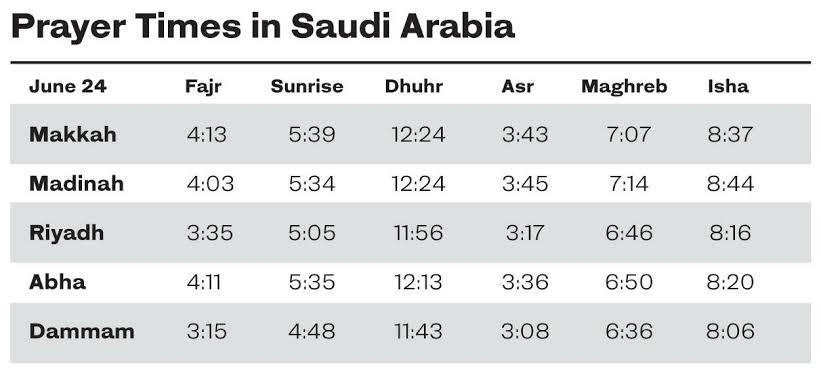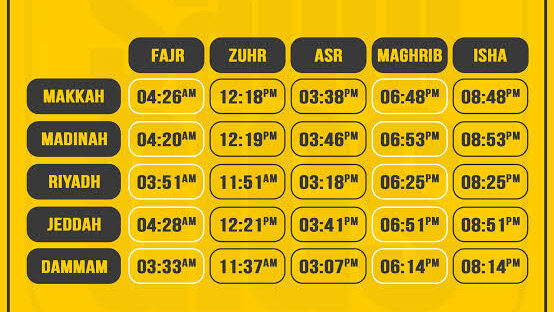Saudi Arabia, home to the two holiest cities in Islam—Mecca and Medina—holds prayer times as one of the most important aspects of daily life. Prayer, or Salah, is a fundamental act of worship that Muslims engage in five times a day. In Saudi Arabia, these prayer times are not only a religious duty but also an integral part of the rhythm of everyday life. From the call to prayer echoing through the streets to the communal prayers performed in mosques, the prayer schedule dictates the pace of both personal and public life. This guide explores the significance of Saudi prayer times, how they are determined, and the impact they have on the daily life of residents and visitors.
The Five Daily Prayers
Muslims around the world are required to perform five daily prayers. These prayers are the Fajr, Dhuhr, Asr, Maghrib, and Isha. Each prayer has its designated time, and it is important for every practicing Muslim to perform them within the specified window. While the precise timing can vary based on geographical location and the time of year, the general principles that determine the prayer times are consistent across the globe.
- Fajr (Dawn Prayer)
The first prayer of the day, Fajr, is performed before sunrise. It marks the beginning of a new day for Muslims. In Saudi Arabia, the Fajr prayer time is determined by the time of dawn, specifically when the first light appears on the horizon. The call to prayer for Fajr often precedes the sunrise by 30 to 45 minutes, alerting the community that it is time to engage in this important spiritual ritual. - Dhuhr (Noon Prayer)
Dhuhr is the second prayer of the day and is performed just after midday, when the sun has passed its zenith. The timing for Dhuhr begins when the sun starts its descent from the highest point in the sky. In Saudi Arabia, Dhuhr usually falls around 12:30 PM to 1:30 PM, depending on the time of year. During this prayer, Muslims gather in mosques for communal worship, though it can also be performed individually. - Asr (Afternoon Prayer)
Asr is the third prayer and takes place in the afternoon, before sunset. The time for Asr is determined by the length of the shadow cast by an object. There are two main opinions regarding the start of Asr—the first is when the shadow is equal to the length of the object, and the second is when the shadow is twice the length of the object. In Saudi Arabia, Asr is typically observed between 3:30 PM and 5:30 PM, varying slightly with the seasons. - Maghrib (Sunset Prayer)
Maghrib is the fourth prayer and is performed immediately after sunset. It marks the end of the daylight hours and the beginning of evening. In Saudi Arabia, the time for Maghrib begins as soon as the sun has completely set below the horizon, and it lasts for a relatively short time. This prayer is typically observed around 6:00 PM to 7:00 PM, depending on the time of year and location. - Isha (Night Prayer)
The final prayer of the day, Isha, is performed after twilight has completely disappeared. This prayer takes place at night and is often observed after the evening activities and family time. In Saudi Arabia, Isha is generally performed after 7:00 PM, but the exact timing can fluctuate based on geographical factors and the season. This prayer is particularly important for Muslims, as it concludes the daily cycle of prayers.

Determining the Prayer Times in Saudi Arabia
The timing of the five daily prayers in Saudi Arabia is based on a variety of factors, including the position of the sun, geographical location, and seasonal variations. In modern times, prayer times are often calculated using sophisticated astronomical algorithms and tools to ensure accuracy.

Sun’s Position and Geographical Factors
The most significant determining factor for Saudi prayer times is the position of the sun. This is why the times for Fajr and Isha change each day, as they depend on the changing angle of the sun relative to the horizon. In Saudi Arabia, which spans a vast geographic area, prayer times can vary from one city to another. For example, in Mecca, the holy city for Muslims, the prayer times may differ slightly from those in Riyadh or Jeddah due to the differences in latitude and longitude.
Seasonal Variations
The length of days and nights in Saudi Arabia can vary significantly throughout the year. During the summer months, the days are longer, and the time between prayers can be shorter, especially for the Maghrib and Isha prayers. In the winter months, the opposite is true, with longer intervals between prayers and shorter days.

The variations in prayer times due to the changing seasons are especially noticeable during Ramadan, the holy month in which Muslims fast from dawn until sunset. Since the timing of the fast is strictly tied to prayer times, Muslims in Saudi Arabia adjust their daily routines based on the specific timings for Fajr and Maghrib.
The Impact of Prayer Times on Daily Life in Saudi Arabia
In Saudi Arabia, prayer times have a profound impact on the daily life of its residents, shaping work, social, and public routines.
Business and Work Hours
Many businesses, government offices, and schools in Saudi Arabia align their schedules around prayer times. For instance, offices and shops often close for a short break during Dhuhr and Asr prayers, and employees are encouraged to pray during these breaks. In larger cities like Riyadh, businesses may take longer breaks during Maghrib and Isha to allow employees to perform their prayers at the mosque.
The prayer schedule also influences the operating hours of public services, including transportation systems, restaurants, and entertainment venues. For example, it is common for restaurants to open later in the evening, aligning with the prayer times for Maghrib and Isha.
Social and Cultural Life
In addition to its impact on work and business, prayer times also play a significant role in the social and cultural fabric of Saudi Arabia. The call to prayer (adhan) can be heard across the country, serving as a reminder for individuals to pause their activities and perform their religious obligations. In urban areas, prayer rooms are often located in shopping malls, airports, and public spaces, ensuring that residents and visitors can observe their prayers conveniently.
Communal prayers are an important aspect of social life in Saudi Arabia, particularly in cities like Mecca and Medina, where the significance of prayer is heightened due to their religious importance. On Fridays, the Jumu’ah (Friday prayer) takes place during Dhuhr, drawing larger crowds for congregational prayers and sermons.
Spiritual Significance
The five daily prayers are not just a routine but a spiritual practice that Muslims engage in to strengthen their connection with Allah (God). In Saudi Arabia, the adherence to prayer times reflects a commitment to faith, discipline, and devotion. These regular moments of reflection throughout the day provide an opportunity for Muslims to renew their focus on spirituality and to seek guidance and forgiveness.
Conclusion
Prayer times in Saudi Arabia represent much more than a religious obligation; they are an integral part of daily life that dictates the rhythm of the day for millions of Muslims. From the early morning Fajr prayer to the late-night Isha, these rituals create moments of reflection, discipline, and connection to a higher purpose. The precise timing of these prayers, influenced by the sun’s position and seasonal changes, has shaped the way people live, work, and socialize in the kingdom. For Muslims in Saudi Arabia, prayer times are a reminder of their faith and a central element of the spiritual and cultural life that continues to define the nation.
Do follow Uae stories for more Updates
Kids Salons in the UAE: A Fun and Relaxing Experience for Young Ones














